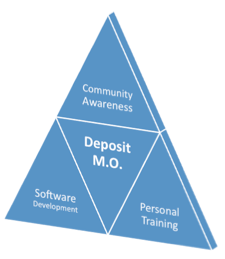 The DepositMO project aims to develop an effective culture change mechanism that will embed a deposit culture into the everyday work of researchers and lecturers. The proposal will extend the capabilities of repositories to exploit the familiar desktop and authoring environments of its users. The objective is to turn the repository into an invaluable extension to the researcher’s desktop in which the deposit of research outputs becomes an everyday activity. The target desktop software suite is Microsoft Office, which is widely used across many disciplines, to maximise impact and benefit. Targeting both EPrints and DSpace, leveraging SWORD and ORE protocols, DepositMO outputs will support a large number of organisations. The ultimate goal is to change the Modus Operandi of researchers so that repository deposit becomes standard practice across a wide number of disciplines using familiar desktop tools.
The DepositMO project aims to develop an effective culture change mechanism that will embed a deposit culture into the everyday work of researchers and lecturers. The proposal will extend the capabilities of repositories to exploit the familiar desktop and authoring environments of its users. The objective is to turn the repository into an invaluable extension to the researcher’s desktop in which the deposit of research outputs becomes an everyday activity. The target desktop software suite is Microsoft Office, which is widely used across many disciplines, to maximise impact and benefit. Targeting both EPrints and DSpace, leveraging SWORD and ORE protocols, DepositMO outputs will support a large number of organisations. The ultimate goal is to change the Modus Operandi of researchers so that repository deposit becomes standard practice across a wide number of disciplines using familiar desktop tools.
Aim and objectiv
The aim of this proposal is to develop an effective culture change mechanism that will succeed in embedding a deposit culture into the everyday work of researchers and lecturers. To make this possible, our objective is to extend the capabilities of repositories to exploit desktop and authoring environments and to turn the repository into an invaluable extension to the researcher’s desktop to address apparent repository weaknesses.
The universal model of repository engagement serves the research community poorly. Emerging from post‐publication library acquisition models (e.g. OAIS), all the work, research and creative effort happens beyond the borders of the repository. It is the finalized research outputs that are currently accommodated in our systems. Only when the research and writing have finished can an individual item be individually uploaded and tagged. To address this situation, the repository needs to provide services that are relevant for researchers.
The typical researcher uses ‘office’ applications to create and edit papers, reports, presentations, posters and teaching materials on their computer desktop. Consequently, the repository must provide better services for the desktop and for office documents. These services should not just be inward looking to make the repository better accommodate office documents, but make the repository a useful source of novel functionality that assists researchers in their daily tasks, including collaboration.
Outputs
A new high‐bandwidth bridge that connects the users’ desktop environment to the repository will be constructed to overcome the specific deficiencies described above that are seen as key barriers to repository deposit, consisting of three parts:
i. a set of components for the Microsoft Office authoring environments and the underlying operating system, such as the Windows Explorer or Mac OS Finder
ii. a suite of enhanced services provided by the repository that work with the desktop/office enhancements and an enhanced SWORD interaction
iii. a bulk upload utility that matches material on the desktop with records in the repository to support away‐from‐office scenarios (e.g. extended archaeological digs) and end‐of-project deposit.
Technology is only part of the solution: An equally important part of this proposal is to help to change the Modus Operandi of the researcher using the following approaches:
i. coaching them to make use of (and hopefully to depend on) the repository for their daily activities. This will be achieved by an expert team, working closely with groups of researchers and library/repository staff to introduce new software and negotiate new working practices.
ii. raising awareness of what is possible in target user communities in archaeology, chemistry, materials science and humanities through existing researcher networks with whom the project team is already working closely.


0 Responses
Stay in touch with the conversation, subscribe to the RSS feed for comments on this post.